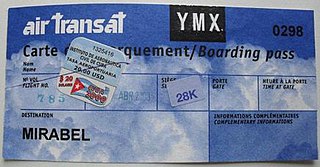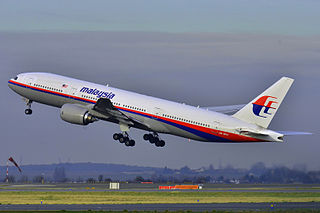Connexion by Boeing (CBB) was an in-flight online internet connectivity service from Boeing. This service allowed travellers to access a high-speed internet connection while on board a plane in flight through a wired Ethernet or a wireless 802.11 Wi-Fi connection. Connexion by Boeing was formed as a separate business unit of The Boeing Company. Major development on the service commenced with a partnership agreement between United Airlines, Delta Air Lines, and American Airlines on June 13, 2001. Lufthansa joined the partnership as the International launch customer on June 17, 2001. United, Delta, and American subsequently withdrew from the partnership after the 9/11 terrorist attacks due to the severe drop in airline travel that occurred after the attacks.
SriLankan Airlines is the flag carrier of Sri Lanka and a member airline of the Oneworld airline alliance. It is currently(as at 2024 April),the largest airline in Sri Lanka by number of aircraft and destinations and was launched in 1979 as Air Lanka following the termination of operations of the original Sri Lankan flag carrier Air Ceylon.
Germanwings GmbH was a German low-cost airline wholly owned by Lufthansa which operated under the Eurowings brand. It was based in Cologne with hubs at Cologne Bonn Airport, Stuttgart Airport, Hamburg Airport, Berlin Tegel Airport, Munich Airport and further bases at Hannover Airport and Dortmund Airport.
Aeronautical Radio, Incorporated (ARINC), established in 1929, was a major provider of transport communications and systems engineering solutions for eight industries: aviation, airports, defense, government, healthcare, networks, security, and transportation. ARINC had installed computer data networks in police cars and railroad cars and also maintains the standards for line-replaceable units.

A boarding pass or boarding card is a document provided by an airline during airport check-in, giving a passenger permission to enter the restricted area of an airport and to board the airplane for a particular flight. At a minimum, it identifies the passenger, the flight number, the date, and scheduled time for departure. A boarding pass may also indicate details of the perks a passenger is entitled to and is thus presented at the entrance of such facilities to show eligibility.

The Broadband Global Area Network (BGAN) is a global satellite network with telephony owned by Inmarsat using portable terminals. The terminals are normally used to connect a laptop computer to broadband Internet in remote locations, although as long as line-of-sight to the satellite exists, the terminal can be used anywhere. The value of BGAN terminals is that, unlike other satellite Internet services, which require bulky and heavy satellite dishes to connect, a BGAN terminal is about the size of a laptop and thus can be carried easily. The network is provided by Inmarsat and uses three geostationary satellites called I-4 to provide almost global coverage.

In-flight entertainment (IFE) refers to the entertainment available to aircraft passengers during a flight. In 1936, the airship Hindenburg offered passengers a piano, lounge, dining room, smoking room, and bar during the 2+1⁄2-day flight between Europe and America. After World War II, food and drink services were offered, and movies were projected onto big screens viewable by all passengers on long flights. In 1985 the first personal audio player became available for purchase, and noise cancelling headphones were introduced in 1989. During the 1990s, the demand for better IFE was a major factor in the design of aircraft cabins. Before then, entertainment came via audio headphone sockets and airline-provided headphones providing music of various genres and the soundtrack of projected movies. Now, in most aircraft, personal IFE display screens are available at most seats, offering entertainment and flight information such as a moving map, speed, and altitude. The advent of small entertainment and communication devices also allows passengers to also use their own devices, subject to regulations to prevent them interfering with aircraft equipment.
Tenzing Communications of Seattle was founded in 1999 by David Coe a small group of private investors and Simon "Symonty" Gresham. Initial funding the key software developed by Symonty. Further development funding was raised from private equity sources and in 2001 Airbus, Cathay Pacific and Rockwell Collins became shareholders. The firm had intended to launch in-flight data services, including text messaging, instant messaging, and email using broadband satellite receivers using Inmarsat's fourth-generation satellite system. However, the satellites were not launched until March 2005, November 2005 and planned April 2008 for the final Pacific Ocean Region, I4 F3.

Panasonic Avionics Corporation (PAC) designs, engineers, manufactures, sells and installs customized in-flight entertainment and communications devices to airlines worldwide. It is a subsidiary of Panasonic Corporation of North America, the principal North American subsidiary of Panasonic Corporation, and operates under the umbrella of the Panasonic Connect group. Panasonic Avionics Corporation was founded in 1979 as Matsushita Avionics Systems Corporation and changed its name in 2005. It is headquartered in Irvine, California and has major business functions in Bothell, WA.

Inmarsat is a British satellite telecommunications company, offering global mobile services. It provides telephone and data services to users worldwide, via portable or mobile terminals which communicate with ground stations through fifteen geostationary telecommunications satellites.

Gogo Business Aviation is a division of Gogo Inflight Internet is a provider of in-flight broadband Internet service and other connectivity services for business aircraft. It is headquartered in Broomfield, CO.

Gogo Inc. is an American provider of in-flight broadband Internet service and other connectivity services for business aircraft, headquartered in Broomfield, Colorado. Through its Gogo LLC subsidiary, Gogo previously provided in-flight WiFi to 17 airlines until the Commercial Air business was sold to Intelsat for $400 million in December 2020. According to Gogo, over 2,500 commercial aircraft and 6,600 business aircraft have been equipped with its onboard Wi-Fi services. The company is the developer of 2Ku, new in-flight satellite-based Wi-Fi technology rolled out in 2015.
AeroMobile Communications Limited is a registered mobile network operator for the aviation industry and is based in the UK. It provides technology and services that allow the safe use of passengers' own mobile phones while inflight. A subsidiary of Panasonic Avionics Corporation its services are often installed alongside Panasonic's Wi-Fi network and can be installed either at the point of aircraft manufacture or retro-fitted across both Airbus and Boeing aircraft. Panasonic Avionic's Wi-Fi network and AeroMobile's mobile phone network are complimentary services and provide passengers with a choice of inflight connectivity options.
FleetBroadband is maritime satellite internet, telephony, SMS texting, and ISDN network for ocean-going vessels using portable domed terminal antennas.
FlyNet is an onboard communication service for Lufthansa.
SwiftBroadband is an IP-based packet-switched communications network that provides a symmetric ‘always-on’ data connection of up to 650 kbit/s per channel for aircraft globally except for the polar regions, using the Inmarsat satellite constellation.
A satellite data unit (SDU) is an avionics device installed in an aircraft that allows air/ground communication via a satellite network. It is an integral part of an aircraft's SATCOM system. The device connects with a satellite via ordinary radio frequency (RF) communication and the satellite then connects to a ground station or vice versa. All satellite communication whether audio or data is processed by the SDU.

The analysis of communications between Malaysia Airlines Flight 370 and Inmarsat's satellite telecommunication network provide the primary source of information about Flight 370's location and possible in-flight events after it disappeared from military radar coverage at 02:22 Malaysia Standard Time (MYT) on 8 March 2014, one hour after communication with air traffic control ended and the aircraft departed from its planned flight path while over the South China Sea.
SES-17, is a high throughput all electric geostationary communications satellite owned and operated by SES S.A., and designed and manufactured by Thales Alenia Space. Launched on 24 October 2021 from Centre Spatial Guyanais (CSG), in Kourou, French Guiana by an Ariane 5ECA launch vehicle, SES-17 was positioned at 67.1° west in May 2022 and, after testing, became fully operational in June 2022.
Honeywell's JetWave is a piece of satellite communications hardware produced by Honeywell that enables global in-flight internet connectivity. Its connectivity is provided using Inmarsat’s GX Aviation network. The JetWave platform is used in business and general aviation, as well as defense and commercial airline users.







